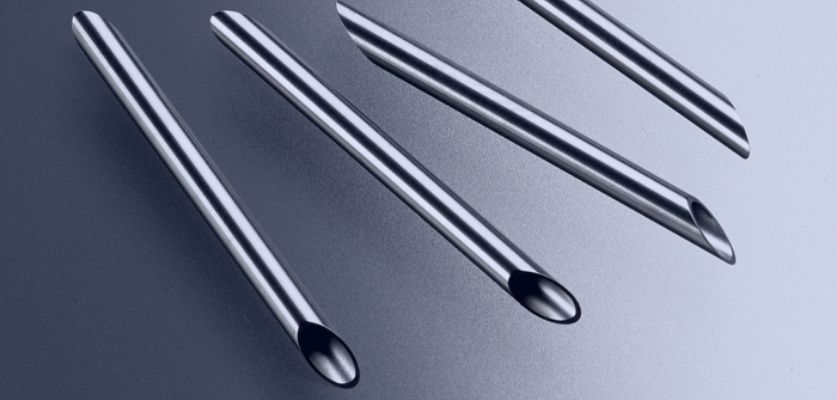The right choices can help to optimize manufacturability.
Since the early days of the twentieth century, stainless steel has played an essential role in the design and production of medical device tubing.
With advances in the technology used to make stainless steel tubing over the years — for example, an inside diameter (ID) as small as 25 microns (µm), or 0.00098”, is now possible — the product has evolved along with the medical field.
A variety of medical device tubing applications
Today, stainless steel comes into play in a wide range of medical procedures. It is well suited to medical device tubing applications requiring a high degree of structure, high tensile modulus (stiffness), or high-pressure fluid flow.
Stainless steel tubing is also used in a variety of medical devices. These include stents, surgical cutting instruments, bone screws, stethoscopes, cannulas, endoscopy equipment, and other devices where the material characteristics — such as the ability to be precisely formed and machined — are critical.
Choosing a medical grade according to the end use
Stainless steel is available in a variety of medical grades that offer:
- Reasonable cost
- Material strength
- Corrosion resistance
- The ability to be precisely formed and machined
Selecting the appropriate medical-grade stainless steel for a particular application is a crucial aspect of medical device tubing design and production. The choice can have an impact on important performance properties, such as abrasion or chemical resistance, hardness, flexibility, and durability.
Equally important, the wrong choice can cause big problems. For example, an incompatible tubing material can chemically alter the liquid flowing through the tube or cause the liquid to bind to the tube wall, resulting in failed delivery.
So when specifying stainless steel — or any material — for medical device tubing, it is critical to look beyond cost alone and consider what is needed for the specific purpose.
For instance, does the medical device tubing need high resistance to liquids or other materials to which it will be exposed? Will the device be implanted and therefore need to be biocompatible as well as corrosion resistant?
Some medical-grade stainless steel options
Relatively strong and with generally excellent chemical and corrosion resistance, stainless steel comes in a variety of medical grades with varying properties.
When choosing stainless steel for medical device tubing, the first step is to understand the end use and then specify the appropriate grade. The following are some examples.
Type 304 stainless steel
The most common grade of stainless steel, type 304 (also known as A2), is inexpensive and readily available in a wide range of standard sizes.
Type 304 stainless steel often contains 18% chromium, a hard and brittle metal that does not tarnish when exposed to air, and 8% nickel, which is known for its corrosion resistance, ductility, and strength.
Versatile and widely used, 304 stainless steel is also known for its forming and welding properties, excellent toughness, and ease of cleaning.
Due to its low carbon composition, 304 is also perfect for high-temperature applications and when seeking to minimize carbide precipitation.
Type 316 stainless steel
The second most common grade of stainless steel, type 316 (also known as A4), is a popular chromium, nickel, and molybdenum-bearing stainless steel that has higher corrosion resistant properties and is somewhat more expensive than 304.
Often called “marine grade stainless steel,” 316 it is not actually resistant to seawater. However, it IS known for resistance to pitting and crevice corrosion in chloride environments.
Therefore, 316 is widely used in applications such as lab equipment, pharmaceutical processing, chemical containers, and surgical implants.
Grade 316LVM stainless steel
Stainless steel grade 316LVM, the low carbon vacuum melt version of 316, is immune from sensitization (grain boundary carbide precipitation). Therefore, it is used extensively in heavy gauge welded components (over about 6 mm, or 0.236”).
For instance, seamless 316LVM stainless steel in the form of medical device tubing has been used to produce coronary stents and devices used in brain surgery.
These are applications where the material must be formed and machined with precise tolerances yet remain free of minute metallic particles.
Deciding if and when tight tolerances are needed
Beyond choosing the grade of stainless steel that is most appropriate (and most cost effective) for medical device tubing, you must also carefully consider the end purpose when you are specifying tube tolerances.
Does your medical device tubing need to serve as a simple conduit for moving a liquid, gas, or other material? Or, must the tube fulfill a measuring function that requires specificity, such as delivering medication or dispensing samples for testing?
If (as in the first example) precision is not a factor in the flow of material through the medical device tubing, then you might not need to specify very tight tolerances.
However, precise sizing of stainless steel tubing may be needed to ensure that the tubes fit into any necessary connections and equipment. In addition, the dimensions of the medical device tubing can influence the flow rate of any liquid that must pass through the tube.
Does the end use require great precision?
In other words, specific medical device tubing applications may require tight tolerances based on various characteristics where precision is required.
For example, with stents that will be inserted and then expand inside tiny arteries, the alloy used might be chosen based on the material’s shape-memory characteristics and biocompatibility — and the surfaces of the stent may need to be specified down to uniform grain size.
With stainless steel tubing for brachytherapy, which involves inserting radioactive implants directly into tissue to treat cancers such as prostate cancer, the tubing wall tolerances must be exact so that the exact amount of radiation is delivered.
Is carryover an issue?
Another important consideration is whether the stainless steel medical device tubing is single use versus reusable — and if it is reusable, as most metal is, whether carryover is an issue.
For example, in 2015, deadly outbreaks of CRE bacteria were linked to carryover contamination in duodenoscopes, which are specialized endoscopes used in about half a million patients each year. Several hospitals found that duodenoscopes can accumulate bacteria that are not always removed by conventional cleaning, passing infections from patient to patient.
For such applications, it may be important to specify stainless steel tubing with an ID surface finish that is as smooth as possible. A smooth ID makes the tubing easier to clean and helps to reduce the chances of infection spread through carryover contamination in reusable tubing.
Are there other surface finish requirements?
In liquid dispensing systems, a smooth ID that enables proper cleaning of the tubing also helps to reduce the total cost of testing and improve test accuracy through more precise sampling.
Additionally, wherever it is critical that liquid is dispensed smoothly, a smooth ID can help to prevent swirling, eddying, or buffeting of the liquid as it moves out of stainless steel tubing. (Read more about liquid dispensing systems.)
A smooth surface finish on the outside diameter (OD) of medical device tubing is also important if the application requires aspirating, in which the entire tube is inserted to draw a vacuum; however, OD surface finish is not a big factor in dispensing processes.
Other considerations for medical device tubing
In addition to meeting industry requirements to qualify as medical grade, stainless steel for medical device tubing may need to meet standards related to the specific application, such as fluid management, anesthesiology or respiratory equipment, intravenous (IV) therapy, peristaltic pumps, lab equipment, or some other end use.
Will the device will be reused?
When the medical device tubing will be reused, the ease with which the material can be sterilized is critical. So, too, is the tubing’s ability to maintain its rigidity, strength, compatibility, resistance, and other characteristics with repeated exposure to disinfectants, sterilization, and routine cleaning processes.
Is a bright surface a pro or a con?
Bright annealed stainless steel is often specified for medical applications because it can be thermocouple cleaned and electropolished for a high degree of cleanliness and smoothness. Electropolishing also creates a chromium-enriched interior surface that can be beneficial.
However, in other cases, such as in an operating room environment, highly bright, smooth medical device tubing may be problematic due to the issues caused by lights reflecting off highly polished surfaces.
Is seamless tubing required?
Welded and redrawn stainless steel tubing may be perfectly acceptable for aspirating or dispensing applications. However, seamless tubing is highly preferred for high-performance liquid chromatography (HPLC) and other high-pressure applications.
Seamless tubing eliminates the risk of leaks, cracks, or ruptures of weld lines when pressure is applied. However, seamless medical device tubing is higher cost, and there are limitations in available sizes, wider tolerances, and longer delivery times.
Are there special coating or finishing requirements?
How stainless steel for medical device tubing will react to specialty coatings — for example, heparin or other drugs that are often applied to stents to increase their therapeutic value — as well as any possible issues associated with a finishing method, must be taken into account when specifying the characteristics of the tubing.
Is the medical device tubing compatible as needed?
Of course, any medical device tubing material must be biologically and chemically compatible with any bodily materials, samples, and systems with which it will have contact.
For example, some biological samples will “stick” to the surface of stainless steel tubing, causing issues such as loss of sample, low yield, and carryover. In this case, stainless steel might be replaced by titanium or another metal that won’t have this “sticking” issue.
(Read more about titanium and other specialty metals for medical device applications.)
Does the material meet the part fabrication requirements?
Whatever material you choose for medical device tubing — whether it is stainless steel or some other metal — it must offer the ability to be cut, drawn, extruded, and finished to achieve:
- The precise length
- A burr-free ID and OD
- The proper wall thickness
- A clean end cut
- All as required for the specific tubing application
The material and its characteristics have an impact on the ultimate performance of the medical device tubing and the systems in which it will be used. So, too, do the specified fabrication method, surface finishing, and other production attributes.
Satisfying application and production needs
Stainless steel, like all materials, has pros and cons that must be assessed for specific medical device tubing requirements and weighed against production needs.
With the many choices that are available, a knowledgeable material supplier can help you select the best option based on your application, budget, and end goals.
To learn more about specifying precision metal tubing for medical devices, download our comprehensive guide, Metal Tubing in the 21st Century: Who Needs It? The Future of Innovation in Medical Devices.






